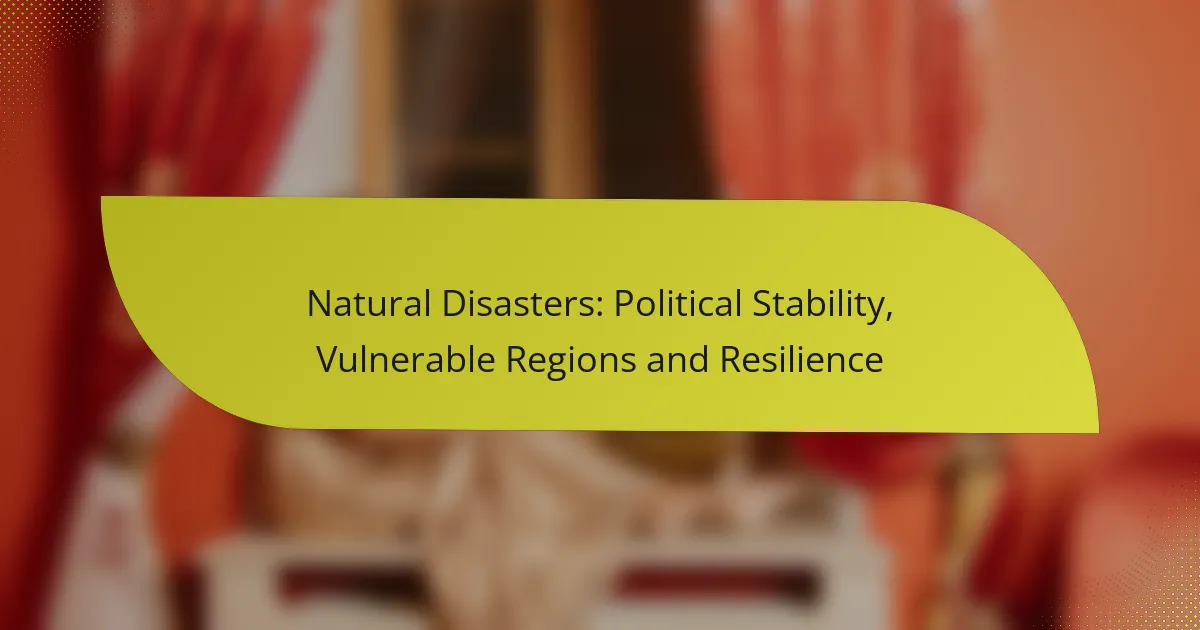Natural disasters pose a significant threat to political stability, particularly in vulnerable regions where governance structures can be severely disrupted. The resulting economic turmoil and loss of public trust in authorities can exacerbate existing vulnerabilities, complicating recovery efforts. To mitigate these impacts, effective resilience strategies must focus on community preparedness, infrastructure investment, and international collaboration.
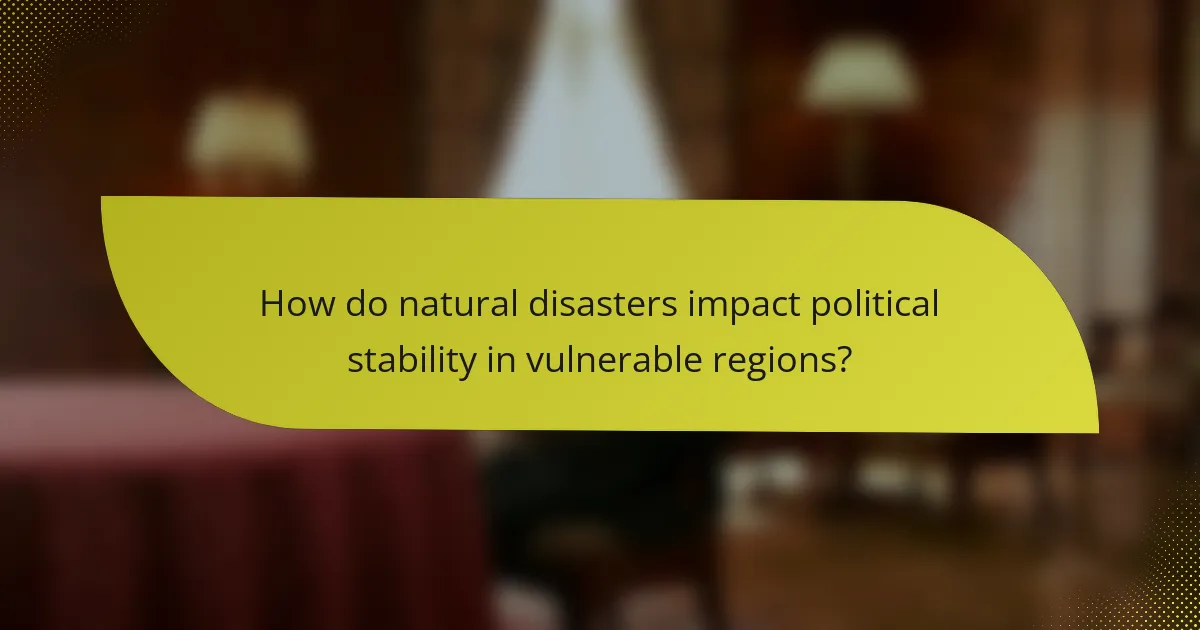
How do natural disasters impact political stability in vulnerable regions?
Natural disasters can significantly undermine political stability in vulnerable regions by disrupting governance structures, escalating conflicts, and causing economic turmoil. These impacts often lead to a loss of public trust in authorities, exacerbating existing vulnerabilities and hindering recovery efforts.
Disruption of governance
Natural disasters can severely disrupt governance by damaging infrastructure, displacing populations, and overwhelming local authorities. When essential services like healthcare, transportation, and communication are compromised, the ability of governments to respond effectively diminishes. This disruption can lead to a governance vacuum, where the rule of law is weakened and local power dynamics shift.
For example, in regions hit by hurricanes or earthquakes, local governments may struggle to maintain order and provide basic services, leading to chaos and uncertainty. The lack of a coordinated response can further alienate citizens from their leaders, creating a cycle of instability.
Increased conflict risk
Natural disasters can heighten the risk of conflict, particularly in areas with existing tensions or resource scarcity. As communities compete for limited resources like food, water, and shelter, the potential for violence increases. Disasters can also exacerbate ethnic or political divisions, leading to unrest and clashes.
In regions where governance is already weak, such as parts of Africa and the Middle East, the aftermath of a disaster can ignite long-standing grievances, resulting in civil strife or insurgency. The interplay of environmental stress and social fragmentation can create a volatile situation that is difficult to manage.
Economic instability
The economic impact of natural disasters can be profound, leading to immediate and long-term instability. Infrastructure damage can disrupt trade and commerce, while the cost of recovery can strain national budgets. In vulnerable regions, where economies may already be fragile, the financial burden of rebuilding can lead to increased debt and reduced public investment.
For instance, countries like Haiti have faced prolonged economic challenges following devastating earthquakes, with recovery efforts hampered by limited resources and external aid dependency. This economic instability can further erode political stability, as citizens become disillusioned with their government’s ability to provide for their needs.
Public trust erosion
Natural disasters can lead to a significant erosion of public trust in government institutions. When authorities fail to respond effectively or transparently during a crisis, citizens may lose faith in their leaders. This loss of trust can have lasting effects, making it difficult for governments to mobilize support for future initiatives or recovery efforts.
In many cases, the perception of corruption or mismanagement during disaster response can further alienate the populace. For example, if aid is perceived to be misallocated or if recovery efforts are slow, public confidence can diminish, leading to protests or calls for political change. Restoring trust after such events requires transparency, accountability, and effective communication from leaders.
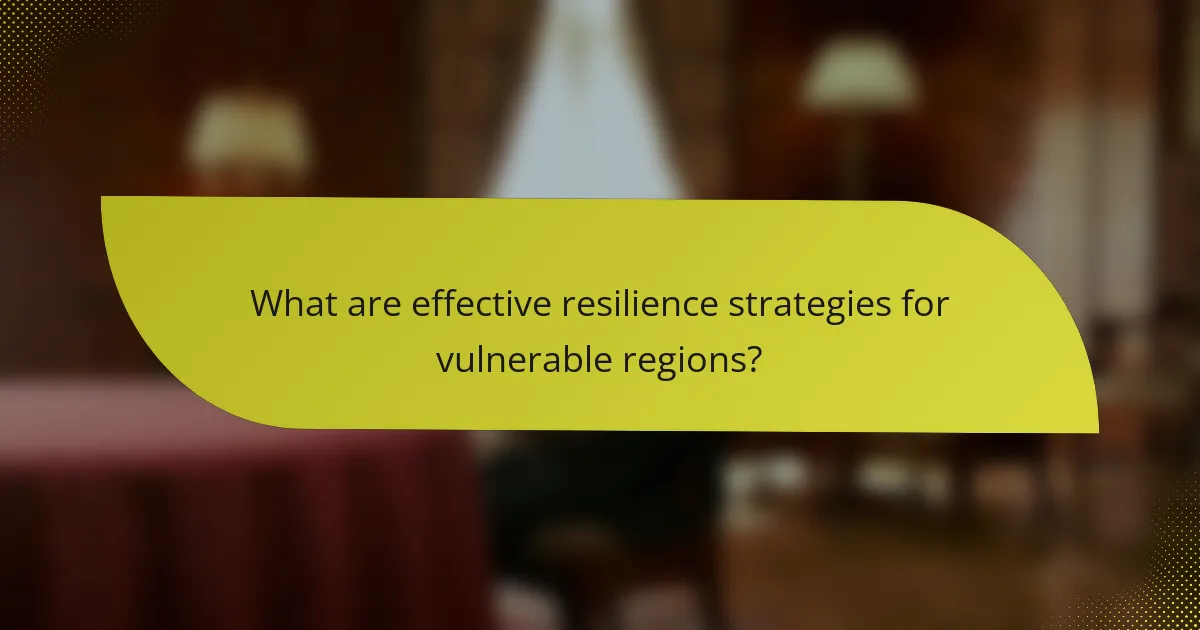
What are effective resilience strategies for vulnerable regions?
Effective resilience strategies for vulnerable regions focus on enhancing community preparedness, investing in infrastructure, implementing policy reforms, and fostering international aid collaboration. These strategies aim to reduce the impact of natural disasters and improve recovery efforts.
Community preparedness programs
Community preparedness programs are essential for equipping residents with the knowledge and skills to respond to disasters. These programs often include training sessions, drills, and the establishment of local emergency response teams. Engaging community members in these initiatives fosters a culture of readiness and resilience.
Examples include workshops on first aid, evacuation procedures, and disaster response simulations. Regularly scheduled drills can help ensure that everyone knows their roles and responsibilities during an emergency, significantly improving response times.
Infrastructure investment
Investing in resilient infrastructure is crucial for minimizing damage during natural disasters. This includes constructing buildings that meet safety standards, reinforcing bridges, and improving drainage systems to handle heavy rainfall. Prioritizing infrastructure upgrades can significantly reduce recovery costs and enhance community safety.
Governments should assess existing infrastructure vulnerabilities and allocate funds accordingly. For instance, retrofitting older buildings to withstand earthquakes or floods can be a cost-effective way to protect lives and property.
Policy reforms
Policy reforms play a vital role in establishing frameworks that support resilience in vulnerable regions. This can involve updating zoning laws to prevent construction in high-risk areas or creating incentives for businesses to adopt disaster preparedness plans. Effective policies should be based on comprehensive risk assessments.
Engaging stakeholders, including local governments and community organizations, is essential for developing policies that address specific regional needs. Regular reviews and updates to these policies ensure they remain effective as conditions change.
International aid collaboration
International aid collaboration enhances resilience by providing resources and expertise that local governments may lack. Partnerships with international organizations can facilitate funding for disaster preparedness initiatives and recovery efforts. This collaboration often includes sharing best practices and lessons learned from past disasters.
Regions vulnerable to natural disasters should actively seek partnerships with global agencies and NGOs. Establishing clear communication channels and mutual agreements can streamline aid delivery during crises, ensuring that support reaches those in need quickly and effectively.
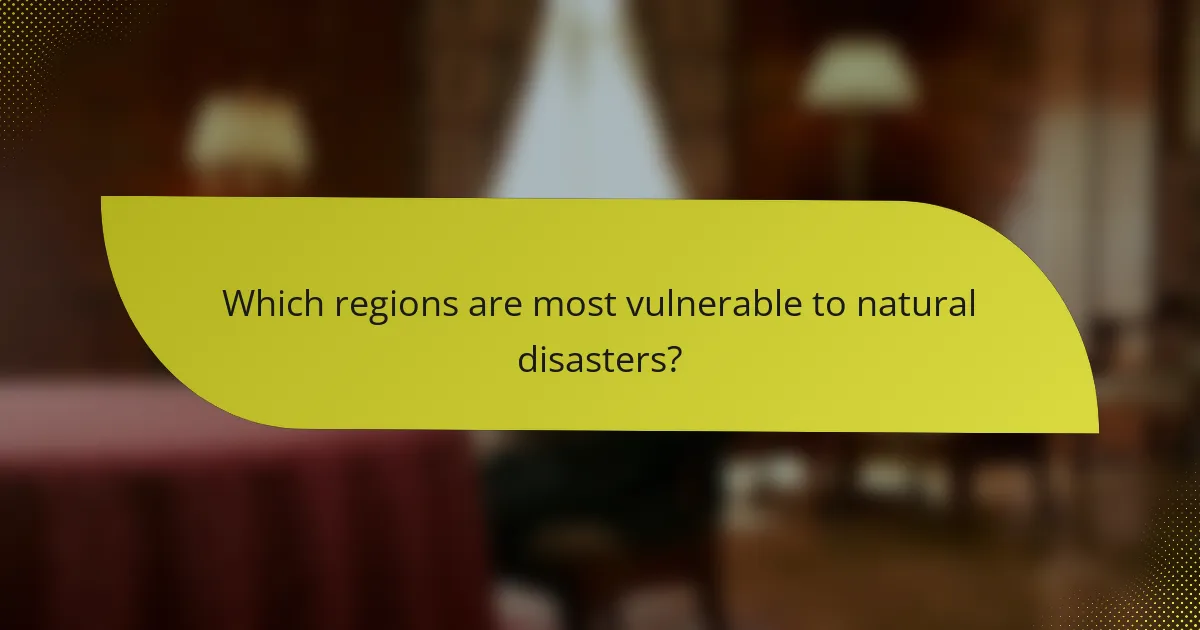
Which regions are most vulnerable to natural disasters?
Regions most vulnerable to natural disasters include areas with high exposure to hazards such as hurricanes, floods, earthquakes, and droughts. Factors like geographical location, socio-economic conditions, and infrastructure resilience significantly influence their vulnerability.
Caribbean islands
The Caribbean islands face frequent hurricanes and tropical storms, making them particularly susceptible to natural disasters. Countries like Haiti and the Bahamas experience significant damage from these events, often leading to loss of life and economic disruption.
Infrastructure in many Caribbean nations is often underdeveloped, which exacerbates the impact of disasters. Building codes may not be strictly enforced, and emergency response systems can be inadequate, leading to prolonged recovery times.
Sub-Saharan Africa
Sub-Saharan Africa is vulnerable to a range of natural disasters, including droughts, floods, and locust invasions. Countries such as Somalia and Sudan often face food insecurity due to these events, which can lead to humanitarian crises.
The region’s limited infrastructure and economic resources hinder effective disaster preparedness and response. Strengthening local governance and investing in resilient agricultural practices are crucial for mitigating these risks.
South Asian countries
South Asian countries like Bangladesh and India are highly prone to monsoon-related flooding and cyclones. The dense population in vulnerable areas increases the risk of casualties and economic losses during such disasters.
Improving early warning systems and community preparedness can significantly reduce the impact of these natural events. Additionally, enhancing urban planning to avoid construction in flood-prone areas is essential for long-term resilience.
Pacific island nations
Pacific island nations, including Fiji and Vanuatu, are at risk from rising sea levels, cyclones, and volcanic activity. Their geographical isolation makes recovery from disasters particularly challenging, often requiring international assistance.
Investing in climate adaptation strategies, such as building seawalls and improving water management systems, is vital for these nations. Community engagement in disaster risk reduction can also enhance local resilience and preparedness.
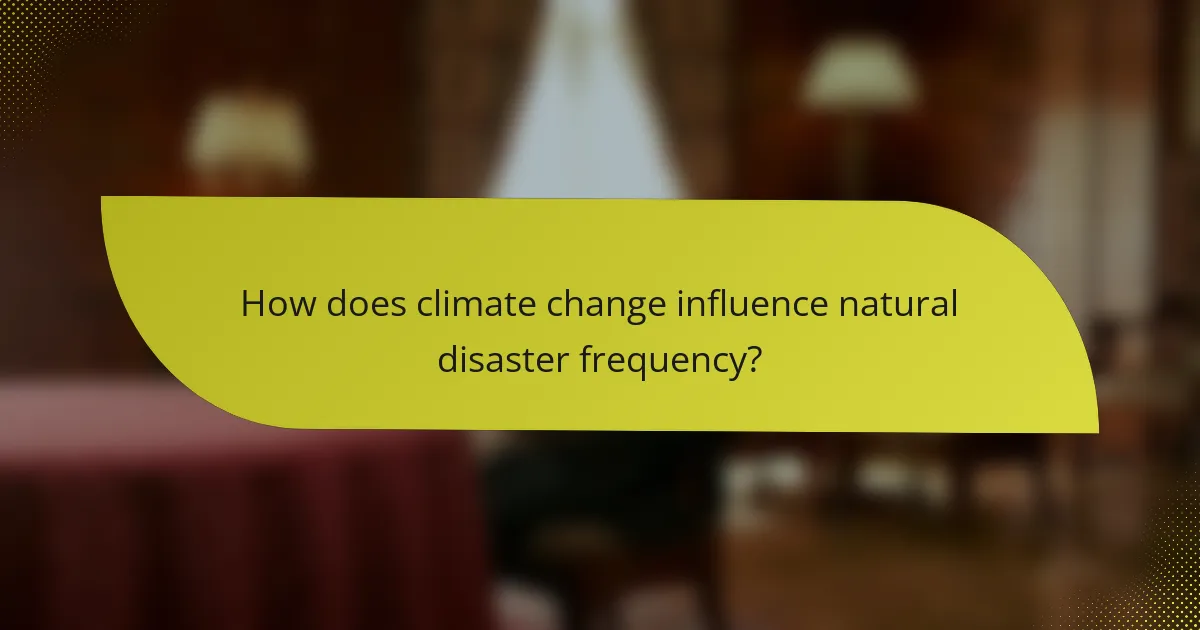
How does climate change influence natural disaster frequency?
Climate change significantly increases the frequency and severity of natural disasters. Factors such as rising temperatures, changing precipitation patterns, and extreme weather events are directly linked to human-induced climate change, leading to more frequent and intense disasters.
Increased storm intensity
Climate change contributes to the increased intensity of storms, including hurricanes and typhoons. Warmer ocean temperatures provide more energy to these storms, resulting in higher wind speeds and greater rainfall. For instance, storms that were once categorized as Category 1 can now escalate to Category 3 or higher due to these conditions.
Regions prone to tropical cyclones, such as the Caribbean and Southeast Asia, are particularly vulnerable. Preparedness measures, such as improving infrastructure and emergency response systems, are essential to mitigate the impact of these stronger storms.
Rising sea levels
Rising sea levels, driven by melting ice caps and thermal expansion of seawater, pose a significant threat to coastal communities. Areas like Florida and Bangladesh are experiencing increased flooding and erosion, leading to displacement and economic losses. Projections indicate that sea levels could rise by several feet by the end of the century if current trends continue.
To combat rising sea levels, coastal cities are investing in flood defenses, such as sea walls and improved drainage systems. Communities should also consider land-use planning that avoids high-risk areas to reduce vulnerability.
Altered weather patterns
Climate change is altering weather patterns, leading to unpredictable rainfall and drought conditions. Regions that previously enjoyed stable climates may now face severe droughts or unexpected heavy rainfall, impacting agriculture and water supply. For example, the Mediterranean region is experiencing hotter, drier summers, while parts of the Midwest in the U.S. are seeing increased rainfall and flooding.
Farmers and local governments should adapt by implementing water conservation techniques and diversifying crops to withstand these changes. Monitoring weather forecasts and climate models can help communities prepare for and respond to these shifts effectively.

What role does international cooperation play in disaster response?
International cooperation is crucial in disaster response as it enhances the effectiveness and efficiency of relief efforts. Collaborative approaches allow countries to pool resources, share expertise, and coordinate actions, ultimately leading to quicker recovery and reduced impact on affected populations.
Resource sharing
Resource sharing among nations can significantly improve disaster response capabilities. Countries often provide financial aid, equipment, and personnel to support affected regions. For instance, during major earthquakes, nations may send search and rescue teams, medical supplies, and temporary shelters to assist in recovery efforts.
Effective resource sharing requires clear agreements and protocols to ensure that aid reaches those in need promptly. Establishing pre-arranged partnerships can streamline the process, reducing delays during critical moments.
Joint training exercises
Joint training exercises among countries prepare teams for real-life disaster scenarios. These exercises simulate various emergencies, allowing responders to practice coordination and communication. Regular drills can improve readiness and build trust among participating nations.
For example, countries in the European Union often conduct joint exercises focusing on natural disasters like floods or wildfires. Such collaborations enhance the skills of responders and ensure a unified approach during actual emergencies.
Information exchange
Information exchange is vital for effective disaster response, enabling countries to share data on risks, resources, and best practices. Timely communication can help predict disasters and coordinate responses more efficiently. For instance, sharing meteorological data can improve early warning systems and help mitigate the impacts of storms.
Establishing platforms for real-time information sharing, such as regional disaster management networks, can facilitate collaboration. Countries should prioritize transparency and accessibility of data to enhance collective resilience against disasters.
